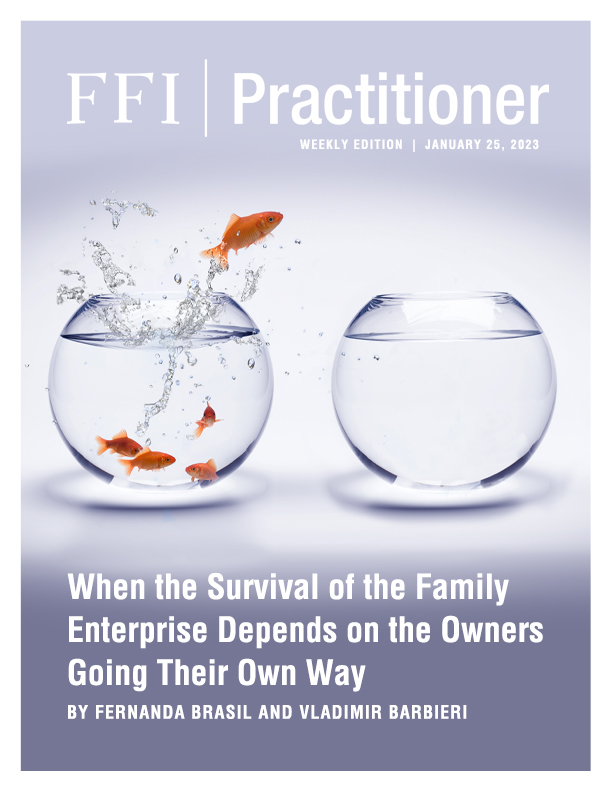
From FFI Practitioner
When family enterprise owners allow conflict to fester to the point where they can no longer make important decisions together, they risk destroying the value of their enterprise.
We have observed that for certain clients, despite their commitment to the enterprise and their desire for good governance, the impact of past wounds and unresolved conflict can prevent family owners from moving forward. At this point, the hard decision to separate might be the right choice for everyone—a choice that can ultimately salvage family relationships and protect the value of the enterprise before both are irrevocably destroyed.
In our experience, although the discussions around separating the ownership group can be painful, they can be handled in ways that minimize the potential of new conflict arising. Agreeing on a fair process for separation can avoid a full-scale feud that threatens the value of the entire enterprise. For example, in some cases it may be wise for advisors to encourage their clients to embark upon a constructive process to divide the family’s assets, negotiate the exit of one or more owners, or sell the business(es) and divide the profits.
However, before a family agrees to any outcome that involves separating, it is important to first establish a transparent and fair process designed to help the owners make informed decisions in an emotional situation. Here are four key suggestions for ensuring that the process goes as smoothly as possible:
Ask the owners to express their individual views of what would be a successful outcome. This should be done in a sentence or two that includes both practical and emotion goals, expressing what each hopes to achieve. For example, one family owner we worked with expressed separation goals this way: “We want to separate our business for independence, freedom of choice, and family preservation. We will work to ensure that we are aligned in the process, seek a sense of fairness, and respect the individual interests of the family’s assets, but recognize that we may not be able to achieve everything.”
Rules of conduct are important to help foster trust during these discussions. We have seen the following examples work well:
Ask the owners to express their individual views of what would be a successful outcome. This should be done in a sentence or two that includes both practical and emotion goals, expressing what each hopes to achieve. For example, one family owner we worked with expressed separation goals this way: “We want to separate our business for independence, freedom of choice, and family preservation. We will work to ensure that we are aligned in the process, seek a sense of fairness, and respect the individual interests of the family’s assets, but recognize that we may not be able to achieve everything.”
Rules of conduct are important to help foster trust during these discussions. We have seen the following examples work well:
- Have all owners (and/or their representatives) commit to working together and actively participating in all meetings. All relevant discussions should happen with everyone in the room. If the ownership group is too big, consider having representatives, but make sure the representatives are keeping their owners aligned and informed.
- Ensure that none of the owners takes any unilateral actions without first reaching consensus with the rest of the group, e.g., avoid one owner talking to a potential buyer before the group has decided to sell.
- Maintain confidentiality and agree on what information, if any, can be disclosed to non-participants, such as spouses.
- Involve third parties, e.g., lawyers, appraisers, M&A firms, only with everyone’s agreement.
- Design a cadence and schedule that balances the desire to move forward with the need to work methodically through complex issues and emotions. Some owners may try to rush the process, while others are reluctant to work through the emotions of separating. If advisors push too hard, some owners may react negatively and make hasty decisions.
It is important to have a clearly defined, consensus vision for the whole process from the beginning, even if the group has not yet worked through all the necessary steps. Consider creating smaller working groups of owners to detail the phases of separation. For example, what does it mean to prepare the company for sale? It might mean reducing investments, cutting unnecessary costs, or bringing in a new CEO who has experience in making sales processes. Establish regular checkpoints to update everyone on the working groups’ progress and confirm next steps. Make sure all deadlines are clearly defined and collectively agreed upon. Deadlines can calm anxiety and bring more commitment to the process.
Suggest hiring advisors who represent all owners and who are perceived as impartial. For example, it could be important to hire a single advisor for the analysis of the tax impacts of the departure of a partner, separation of assets, or the sale of the family business.
It is important to have a clearly defined, consensus vision for the whole process from the beginning, even if the group has not yet worked through all the necessary steps. Consider creating smaller working groups of owners to detail the phases of separation. For example, what does it mean to prepare the company for sale? It might mean reducing investments, cutting unnecessary costs, or bringing in a new CEO who has experience in making sales processes. Establish regular checkpoints to update everyone on the working groups’ progress and confirm next steps. Make sure all deadlines are clearly defined and collectively agreed upon. Deadlines can calm anxiety and bring more commitment to the process.
Suggest hiring advisors who represent all owners and who are perceived as impartial. For example, it could be important to hire a single advisor for the analysis of the tax impacts of the departure of a partner, separation of assets, or the sale of the family business.
If the owners agree, suggest that they choose selection criteria and a process for hiring a collective advisor. These are important questions that should be answered in advance of interviewing candidates:
- Will the advisor have a primary point of contact among the group of owners?
- Who will, in turn, communicate with the rest of the ownership group?
- Will communications be by email with copy for everyone, or by some other agreed-upon method?
Most importantly, make sure everyone agrees on how the advisor will work with the owner group to make recommendations.
Next steps
Once the owners have agreed upon the process for general parameters of the pending separation, commit an outline of the understanding to writing. This outline should include the schedule of the asset separation. The sale or division of family-owned assets is typically phased, so advisors should ensure that a plan is in place to manage these assets throughout the process.
What if they can’t agree about how to separate?
In some cases, continuing together as an ownership team can be detrimental to the current and future value of the enterprise, and yet no one wants to sell his or her shares. Sometimes, the family may fail to reach a consensus on a fair division of assets. When stalemates occur, there are several approaches that can help to avoid a protracted legal battle. Some of these may be unorthodox, but they can be effective to help families reach an agreement:
- Draw for who gets the business and who should sell their share, from pre-arranged premises such as valuation, form of payment, etc.
- Use the “shotgun” process: one side makes an offer, and the other side has to buy or sell based on the offer.
- All sides make a “sealed” offer at the same time, and the best offer is the winner.
- A mediator proposes how to divide, and each side chooses its preferred option—if everyone wants the same “share,” the mediator adjusts and tries again.
When the survival of the family and family business depends on each owner going his or her own way, it’s in everyone’s interest to work hard on a fair process for separation. This fair process may be the best chance not to destroy what remains of family assets. And the family just might end up with mutual respect, rather than grudges, at the end of the process.






